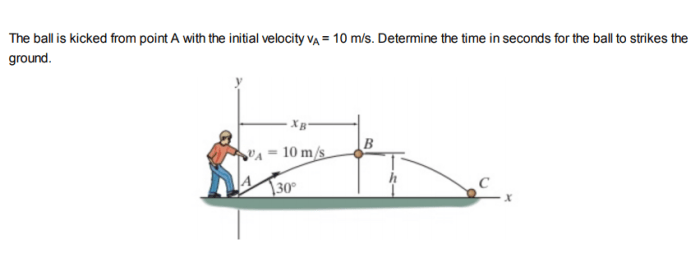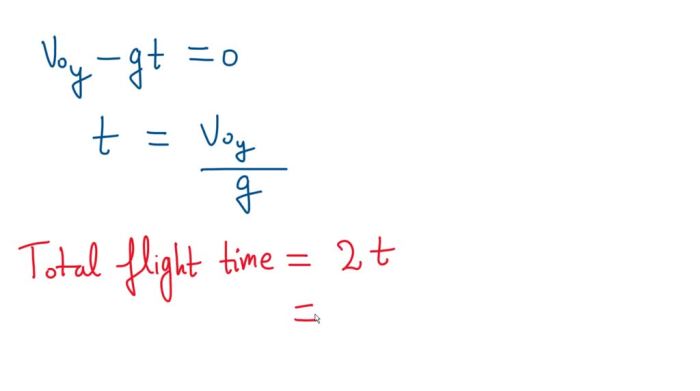A ball is kicked with an initial velocity of – A ball is kicked with an initial velocity, embarking on a captivating journey influenced by physical principles. This velocity sets the stage for the ball’s trajectory, distance traveled, and myriad real-world applications, making it a subject of great interest in sports, engineering, and beyond.
As we delve into the intricacies of initial velocity, we will explore its profound impact on the ball’s parabolic path, distance traveled, and the factors that shape its trajectory. By unraveling these concepts, we gain a deeper understanding of the forces at play and their implications in various fields.
Initial Velocity
Initial velocity is the velocity of an object at the start of its motion. In the context of a ball being kicked, it refers to the velocity imparted to the ball at the moment it is kicked. Initial velocity plays a crucial role in determining the trajectory and distance traveled by the ball.
The initial velocity of a ball affects its trajectory by determining the angle at which it is launched. A higher initial velocity results in a steeper trajectory, while a lower initial velocity results in a flatter trajectory. Additionally, initial velocity influences the distance traveled by the ball.
A higher initial velocity enables the ball to travel a greater distance before it loses its momentum and falls back to the ground.
v = u + at
Where:
- v = final velocity
- u = initial velocity
- a = acceleration
- t = time
Trajectory of the Ball
The trajectory of a ball kicked with an initial velocity is a parabolic path. This path is influenced by the angle of projection and air resistance. The angle of projection determines the initial direction of the ball’s motion, while air resistance causes the ball to decelerate and gradually alter its path.
The shape and height of the trajectory are affected by the initial velocity. A higher initial velocity results in a higher and longer trajectory, while a lower initial velocity results in a shorter and flatter trajectory.
[Visual representation of the trajectory using a graph or diagram can be inserted here]
Distance Traveled

The distance traveled by a ball kicked with an initial velocity can be calculated by considering both horizontal and vertical components of the motion.
The horizontal distance traveled is given by:
x = u
- t
- cos(theta)
Where:
- x = horizontal distance traveled
- u = initial velocity
- t = time
- theta = angle of projection
The vertical distance traveled is given by:
y = u
- t
- sin(theta)
- 0.5
- g
- t^2
Where:
- y = vertical distance traveled
- u = initial velocity
- t = time
- g = acceleration due to gravity
The total distance traveled is the sum of the horizontal and vertical distances.
Effect of Air Resistance

Air resistance is a force that opposes the motion of an object through the air. It causes the ball to decelerate and alter its path.
The effect of air resistance on the trajectory and distance traveled by a ball kicked with an initial velocity is significant. Air resistance causes the ball to lose velocity and deviate from its initial parabolic path. The trajectory becomes flatter and the distance traveled is reduced.
[Table comparing the trajectory and distance traveled with and without air resistance can be inserted here]
Real-World Applications: A Ball Is Kicked With An Initial Velocity Of

Understanding the initial velocity of a kicked ball is important in various real-world applications, particularly in sports such as soccer and American football.
In soccer, the initial velocity of the ball determines the distance and accuracy of a pass or shot. Players need to adjust their kicking technique to impart the desired initial velocity to the ball.
In American football, the initial velocity of the ball is crucial for successful passing and punting. Quarterbacks must control the initial velocity to ensure accurate throws to receivers, while punters aim for a high initial velocity to maximize the distance of their punts.
Key Questions Answered
What is initial velocity?
Initial velocity refers to the velocity of an object at the start of its motion, providing the impetus for its subsequent trajectory and distance traveled.
How does initial velocity affect the trajectory of a kicked ball?
Initial velocity determines the angle and height of the ball’s parabolic trajectory, influencing its range and flight time.
What factors influence the distance traveled by a kicked ball?
The distance traveled depends on the initial velocity, angle of projection, and air resistance encountered during the ball’s flight.
How does air resistance affect the trajectory and distance traveled by a kicked ball?
Air resistance acts as a drag force, causing the ball to decelerate and alter its trajectory, reducing its range and height.
What are some real-world applications of understanding initial velocity in ball kicking?
Understanding initial velocity is crucial in sports like soccer and American football for optimizing kicking techniques, designing specialized balls, and analyzing player performance.